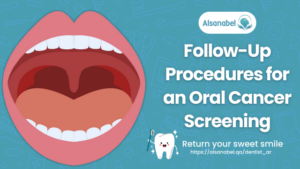Oral cancer screenings play a crucial role in early detection and improving treatment outcomes. Knowing what to expect during this essential procedure can help ease any apprehensions and empower individuals to prioritize their oral health. With a combination of visual exams, palpation, and advanced screening methods, healthcare providers can swiftly assess and monitor any abnormal areas in the mouth and throat. Let’s delve into the process of oral cancer screening and gain insights into its significance in safeguarding overall well-being.
Preparation for an Oral Cancer Screening
Preparing for an oral cancer screening involves a few simple steps at our dental clinic:

- Provide Medical History: Share details about your medical history, including oral health issues, family history of cancer, and lifestyle habits like smoking or alcohol use.
- Update Medications: Inform your dentist about any medications you’re taking, including supplements, as some may affect oral health or cancer risk.
- Avoid Eating or Drinking: Refrain from eating or drinking for at least an hour before the screening to ensure clear visibility.
- Remove Oral Appliances: Take out removable oral appliances like dentures or mouthguards to allow thorough examination.
- Arrive Early: Arrive a few minutes early to complete paperwork and provide updated information.
- Stay Relaxed: Remain calm during the screening; dental professionals will explain the process and address any concerns.
- Ask Questions: Don’t hesitate to ask questions about the screening procedure to alleviate any worries.
Following these steps helps ensure a successful screening and contributes to overall oral health and well-being.
Visual Examination for an Oral Cancer Screening
During an oral cancer screening, a visual examination at best dental clinic in Qatar is conducted:
- Inspection of Oral Cavity: The dentist examines the lips, gums, tongue, cheeks, palate, floor of the mouth, and throat.
- Search for Abnormalities: Using a bright light and sometimes instruments, they look for sores, lumps, lesions, discolorations, or growths.
- Palpation: They may gently feel the oral tissues and lymph nodes for swelling, tenderness, or abnormal textures.
- Documentation: Suspicious findings are documented, including location, size, and color, for tracking changes and communication with other healthcare providers.
- Patient Education: The dentist educates the patient about the importance of screenings, risk factors, and self-examination techniques.
- Follow-up Recommendations: Based on findings, recommendations for further screenings, tests, or preventive measures may be provided.
Regular screenings are crucial for early detection and maintaining oral health.
Physical Examination for an Oral Cancer Screening
During a physical examination for an oral cancer screening:
- Inspection of Oral Tissues: The dentist visually checks for abnormalities like sores, lesions, or discolorations on the lips, gums, tongue, cheeks, palate, floor of the mouth, and throat.
- Palpation of Oral Structures: They gently feel the oral tissues and lymph nodes for swelling, tenderness, or unusual textures.
- Evaluation of Mobility and Function: Assessing tongue, jaw, and oral structure movement to detect abnormalities.
- Examination of Dentition: Evaluating teeth, gums, and supporting structures for signs of chronic irritation or inflammation.
- Documentation and Recording: Suspicious findings are documented for tracking changes and communication with other healthcare providers.
- Patient Education and Counseling: Educating patients about the importance of screenings, risk factors, and self-examination techniques.
- Follow-up Recommendations: Providing recommendations for further screenings, tests, or preventive measures based on findings.
Regular screenings are crucial for early detection and improved treatment outcomes, especially for those with risk factors like tobacco use or HPV infection.
Additional Diagnostic Tests for an Oral Cancer Screening
Additional diagnostic tests for oral cancer screening beyond visual and physical examination at best dental clinic in Qatar may include:
- Toluidine Blue Staining: This dye selectively stains abnormal cells, aiding in identifying potential abnormalities.
- Brush Biopsy (Exfoliative Cytology): Scrapes cells from lesions for microscopic examination.
- Tissue Biopsy (Incisional or Excisional): Surgically removes tissue for definitive microscopic examination.
- Fluorescence Visualization (VELscope or ViziLite): Special light sources enhance detection of abnormal tissues.
- Salivary Biomarker Testing: Analyzes saliva for molecular changes associated with oral cancer.
- CT Scan (Computed Tomography): Produces detailed cross-sectional images to evaluate lesion extent.
- MRI (Magnetic Resonance Imaging): Generates detailed images of soft tissues for further evaluation.
- PET-CT Scan (Positron Emission Tomography-Computed Tomography): Combines functional and anatomical imaging to detect cancerous lesions or metastases.
These tests aid in obtaining more information about suspicious lesions, guiding treatment decisions, and improving patient outcomes through early detection and intervention.
Follow-Up Procedures for an Oral Cancer Screening
After an oral cancer screening, follow-up procedures are crucial for monitoring suspicious findings and ensuring timely diagnosis and management. Here are common follow-up steps:

- Regular Dental Check-ups: Maintain routine check-ups with a dentist for ongoing monitoring and early detection of changes.
- Self-Examination: Perform regular self-examinations of the oral cavity to detect any abnormalities between dental visits.
- Scheduled Follow-up Appointments: Additional appointments may be scheduled for further evaluation or consultations with specialists if suspicious lesions are identified.
- Biopsy or Referral for Biopsy: Tissue biopsy may be performed to confirm diagnosis, followed by appropriate treatment or monitoring.
- Imaging Studies: CT scans, MRI scans, or PET-CT scans may be recommended to assess disease extent and guide treatment planning.
- Consultation with Specialists: Referral to specialists like oncologists or head and neck surgeons for comprehensive evaluation and treatment planning.
- Long-term Surveillance: Patients diagnosed with oral cancer require ongoing monitoring for recurrence or metastasis through regular follow-up appointments and imaging studies.
Adhering to follow-up schedules and communicating with healthcare providers at our dental clinic is crucial for optimal outcomes in managing oral cancer and related conditions. Early detection and comprehensive care contribute to better prognosis and quality of life.
Thank you for taking the time to learn more about what to expect during an oral cancer screening. It’s important to stay informed and proactive when it comes to your oral health. If you have any questions or concerns, don’t hesitate to reach out to your dentist or healthcare provider. Remember, early detection is key in successfully treating oral cancer. Stay informed, stay healthy.
